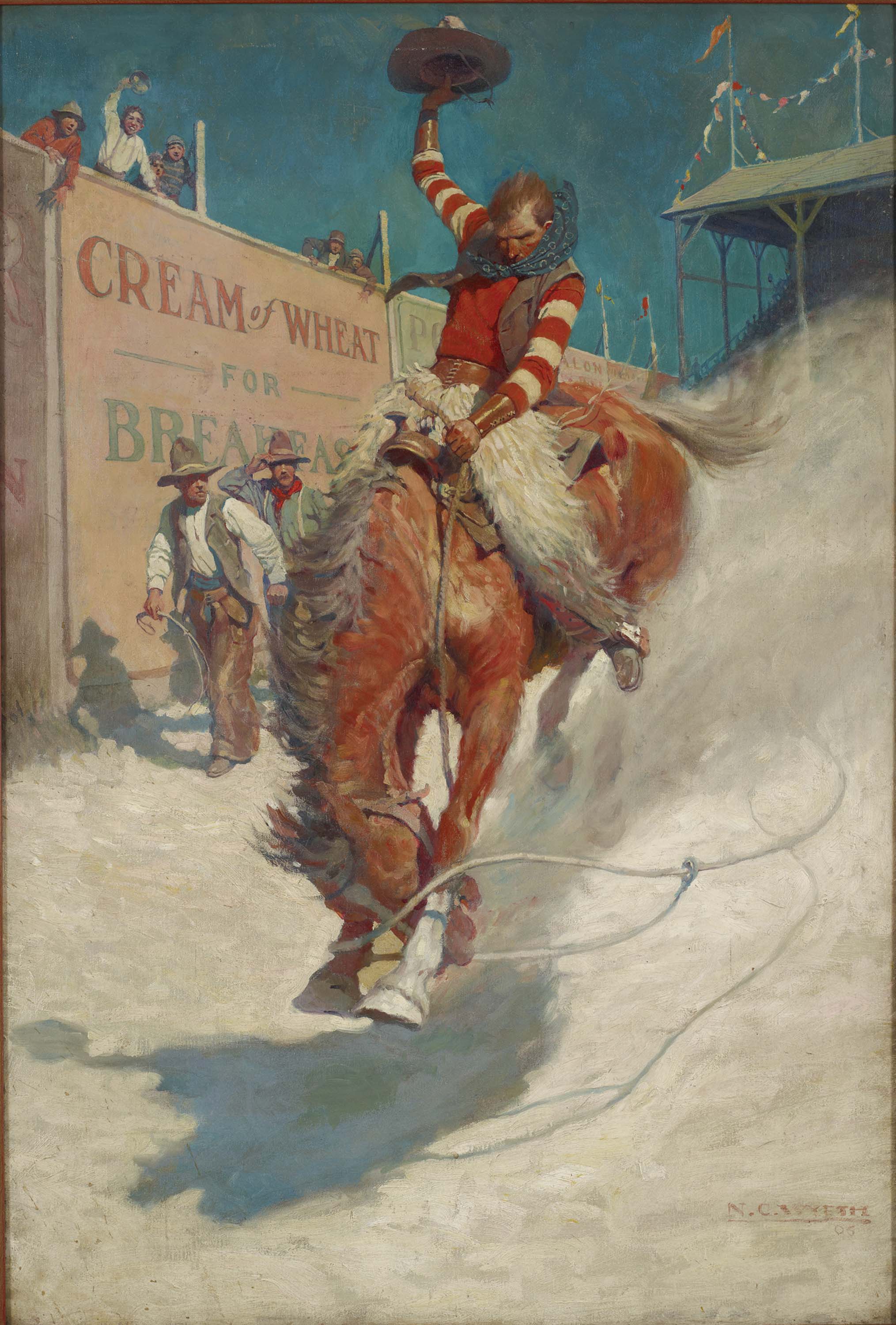
01 Dec Perspective: N.C. Wyeth [1822-1945]
It’s not a man’s world but a boy’s, as the Treasure Island frontispiece suggests — its illustration bulging with the enlarged feet and arms of musket-bearing pirates that “jump out at you and grab your neck,” N.C. Wyeth’s son, Andrew, would observe. It’s the bushwhacking archers of Robin Hood or the impossibly muscular Indians of The Last of the Mohicans, illustrations of a sort that N.C.’s grandson, Jamie, would categorize as “electrifying,” with “a bravado” and “the intense colors — all done before television.” Perhaps more than these novels’ texts, N.C.’s illustrations fling us back in time — to medieval and 18th-century England, to the pirate-infested Caribbean, to King Arthur’s court — transporting readers from the odd tedium or torpor of childhood to lands where adventure is paramount, heroism possible and romance abounds. And though his work illustrating historical fiction is what we best remember N.C. for, his career did not begin there. It began in the wild West of the 20th century.
Newell Convers Wyeth was the first son of a troubled mother, “hysterical” and “nervous,” in the day’s parlance, who at age 8 and in a fit of jealousy may have drowned her infant brother in the Charles River. Hattie Wyeth would become so clinging to her first son that when N.C. left his Needham, Massachusetts, home at age 20 for Howard Pyle’s School of Illustration Art, in Wilmington, Delaware, she memorialized the date, October 19, 1902, and never let him forget it. A midlife painting by N.C., My Mother, suggests her sorrow at his departure and the stooped-shoulder resolve of the figure leaving. Hattie would spend decades infantilizing her son. In 1906, at his engagement to his future wife, she showed N.C. a recently framed baby picture and said, “I felt I must get you back in that form,” as David Michaelis in N.C. Wyeth: A Biography reports.
A 1902 sketch, Bronco Buster, for The Saturday Evening Post, was N.C.’s first cover work. And its exuberance set him apart from the apprentices at Pyle’s studios in both Wilmington and Chadds Ford, Pennsylvania. It would be the first of the Western illustrations he published throughout his life. It is alive with the exhilaration of escape.
Wyeth fled to the American West — as had Frederic Remington, Edward Curtis, Thomas Moran and Theodore Roosevelt — in part to solidify his manhood. “Wyeth wanted his art to be ‘virile,’” says Christine Podmaniczky, curator of the N.C. Wyeth collections for the Brandywine River Museum and editor of his catalogue raisonné. “And what better subject than ‘the great West?’” During two trips, one in 1904, the other in 1906, Wyeth herded cattle, delivered mail via Pony Express and rejoiced in the freedom from maternal bonds. The trips produced work that was stunningly original. As Podmaniczky says, “Wyeth’s energy is palpable, the action amazing and the color gorgeous.”
His paintings were ecstatic. And youthfully consistent: The frenzies of 1905’s Cutting Out or Rounding Up are not far removed from the comic enthusiasms of The Wild, Spectacular Race for Dinner. His colors are vivid: bright blues, reds and blinding whites against the chestnut hides of cattle or horses.
Even the grim stoicism of the dust-blown freighter, in 1907’s The Ore Wagon, is overwhelmed by a joyous rush forward. Paintings from N.C.’s 1906 trip to Colorado for an Outing magazine story, “How They Opened the Snow Road,” are “alternately subtle and intense,” says Podmaniczky. “Wyeth captured so well the look of the icy temperatures, the snow and the winter sky. The painterliness with which he creates these scenes is so accomplished.”
The pictures were grounded in observation — Wyeth had been there. Stylistically they did much to separate him from the medievalism of his teacher, Howard Pyle, the premier illustrator of his day, a champion of the old and decrier of the new. And it helped gird him against the constant attentions of his mother, who wished them to be “children together,” as Michaelis reports, she his “one and only,” and he her “shining light.”
Wyeth’s frontier mentor had been Frederic Remington. According to Michaelis’ biography, N.C. believed “the great West … has never been painted except by [him],” but “he has only pictured the brutal and gory side of it … ” Remington’s palette often was dark — his most accomplished paintings were nocturnes — but Wyeth, with bright colors and sublime liveliness, celebrated its jubilant side. He expressed his joy in the company of men, the distance felt from Hattie and from his new fiancée, Carolyn Bockius.
That lightness and energy proved popular with magazines. From the first Wyeth’s success there was the envy of his contemporaries. The earliest of his Western illustrations were for Scribner’s, McClure’s, Outing and The Saturday Evening Post. He did advertising work for Cream of Wheat, Coca-Cola and other companies. Editors commissioned paintings that by the time of his death numbered several thousand.
Hollywood directors plagiarized his sketches, but not without flattering him. N.C. wrote of the 1920 adaptation of The Last of the Mohicans that the director “very obviously followed my pictures with marked fidelity … At times I felt as though some of my pictures had suddenly come to life.” Mohicans had been a Scribner’s Classic, and Wyeth would illustrate numerous others for that house, including The Deerslayer, Kidnapped, Robinson Crusoe, The Mysterious Island and Westward Ho!.
Despite his commercial success, he held the illustrator’s singular dissatisfaction with the trade: “If only someday I can be called a painter!”
Ironically he had the fortune to be working in the golden age of American illustration, the early 20th century. That was an era before photography’s dominance, when modern printing more accurately reproduced a painting’s color and when almost every book, story or article required illustration. Wyeth wrote, in a 1912 New York Times essay titled “A Suggestion and Comment on Illustrating Fiction,” that “The illustrator must first feel the power of a story in all its rhythm and swing … You have to register in your mind how it works … you must single out the color of the story.”
The illustrator must also encourage a suspension of disbelief, creating a meditative space where the reader’s and buyer’s subconscious is captivated by the product. “[A picture] is in short a form of advertisement.” Such dreamlike commercialism required negotiating the territory between romance and reality, fantasy and fact.
That tightrope walk was a feat Wyeth struggled to maintain. His Western illustrations celebrated the romance of a vanishing frontier, yet moved him toward realism and reality, away from the fantasy life he’d cultivated to bear the dominance of his mother. That he resented this work’s demands is both curious and understandable. “The artistic powers of an illustrator spring from the same source as do the powers of the painter,” he wrote, “but the profound difference lies in the fact that the illustrator submits his inspiration to a definite end; the painter carries his into infinitude.”
Hattie Wyeth died on August 11, 1925. She had been hospitalized for depression, but had returned to her Needham, Massachusetts, home. N.C. was not present at her demise. Afterward, in sadness, he scrawled, “How little I have expressed the true me, and how much there is of me to express.” Their relationship had been crippling. And the enmeshment he’d known — that compulsive caring and drive to be cared for — would be transferred to his surviving family. As Michaelis writes, “Emotional stability eluded him. He would be dependent on others to maintain equilibrium all his life.”
His Western art grew brighter after Hattie’s death, and its subjects less frenzied. In 1937’s Cowboy Watering His Horse (an ad for Coca-Cola), the rider hunkers, Buddha-like, beside his mount as it drinks from a stream. The cowboy’s shirt is alfalfa green and the Rockies loom white as the Himalayas. In 1935’s Seeking the New Home, a pioneer woman stoops beside a Conestoga wagon to fix a meal for her children with the contentment of a mother serving dinner in a New England saltbox.
In Hattie’s absence, Wyeth’s paintings of the East — though their colors were striking — grew darker and more meditative. The War Letter, painted in 1941, is predictably bleak, and 1935’s April Rain, while light blue-gray in tone and springlike, shows a farmer hunched in contemplation or melancholy as he tends his herd. These must have been satisfying to N.C. as art. Yet he’d said as early as 1912, that he was “sick” of illustration. “I want to start over, I want to wipe the slate clean of everything but my family.”
He added, “There has been in my cosmos two factions warring ever since I can remember.” He meant his inclination to, in his view, produce “bad” rather than “good” art, and his wish to create the latter. A compromise had been reached: When illustrating, he tried to make the resultant paintings count. In magazines they would be reproduced, at best, in a 10-by 14-inch format. But as Jamie says, “For some reason [he] did these huge things” — 42 by 32 inches, and sometimes 52 by 34 inches. Michaelis posits that “Wyeth had used his clashing selves to give popular literary forms a graphic concreteness they had not had before.” Already he had “succeeded in making Westerns, folktales, historical romances and stories of adventure and exploration his own emotional property.”
The public, and some critics, found his private work less compelling. In his middle years the Pennsylvania landscapes and Maine seascapes became dreamlike, even hallucinatory — after the style of Thomas Hart Benton. Michaelis argues that Wyeth, in his personal work, was unable to confront the feelings of rage and entrapment seething from his relationship with his mother. Yet others feel that N.C.’s Chadds Ford and New England paintings represent the best of his mature efforts. “Ultimately, of course,” Podmaniczky says, “Wyeth realized that he loved Pennsylvania and New England too much to devote his life and art to the West.”
It was in Chadds Ford that he would conclude that life. Though working diligently, he’d entered a deep relationship with his daughter-in-law, Caroline Pyle Wyeth (Howard Pyle’s niece), that some, including family members, believed was not foolishly romantic, but sexual. On the morning of October 19, 1945, his car was struck on railroad tracks near the Wyeth farm by a locomotive that flung the station wagon and its passengers, N.C. and Caroline’s four – year – old son, Newell, 143 feet forward, killing them both. Some thought the accident had been suicide. Others believed that Newell, in addition to being his namesake, had also been N.C.’s child. Everyone knew the painter had been gravely depressed. And he was a son who would have remembered that October 19, 1902, was the date his mother always said was the day he’d left her for Pyle. That last morning he had been painting First Farmer of the Land, a portrait of George Washington, himself no meek explorer of the frontier. The West could not have been far from N.C.’s mind.
Its vigor would remain with the Wyeths, who in their art and colorfully individualistic lives have remained genteel outlaws. Andrew eschewed painting the West, but Jamie, in 1965’s Draft Age, embraced its spirit, if not its fact. “I have to think that Jamie Wyeth’s work is closest to N.C.’s,” Podmaniczky says. “NCW and Jamie both love the tactile qualities — the malleability — and possibilities of oil paint. As far as Draft Age goes, I think it’s one of Jamie’s finest paintings.”
In that work, the artist — celebrated for his portraits of J.F.K., Andy Warhol, Rudolf Nureyev and others — painted a teenage Chadds Ford neighbor in a zippered motorcycle jacket, black gloves and wraparound shades above a Brandoesque sneer. It is so Western that the black jacket might have been a cowboy’s duster, the tapered glasses a cocked Stetson. It would not be until 1969 that Peter Fonda’s and Dennis Hopper’s film, Easy Rider, hitched motorcycle outlawry to the bronco-busting ethos of a lost frontier. For years, Draft Age hung in the Chadds Ford Inn, not far from where N.C. Wyeth had died. It seemed Jamie had crafted the painting not just to remind viewers of their status and mindset in 1965, but to celebrate his grandfather’s sojourns in Colorado and New Mexico, the legacy those trips produced and his family’s debt to the American West.
- N. C. Wyeth, “Self Portrait with Palette” | Oil on Canvas | 1909/1912 | Private Collection
- N.C. Wyeth, “The War Letter” | Tempera and Oil on Hardboard | 1944 | Collection Brandywine River Museum of Art
- N.C. Wyeth, “My Mother” | Oil on Canvas | 1929 | Collection Brandywine River
- N.C. Wyeth, “The Ore Wagon” | Oil on Canvas | 21.5 x 34 inches | 1907
- N.C. Wyeth, “Cowboy Watering His Horse” | Oil on Canvas | 36 x 24 inches | 1937
- Jamie Wyeth, “Draft Age” | Oil on Canvas | 30 x 30 inches | 1965






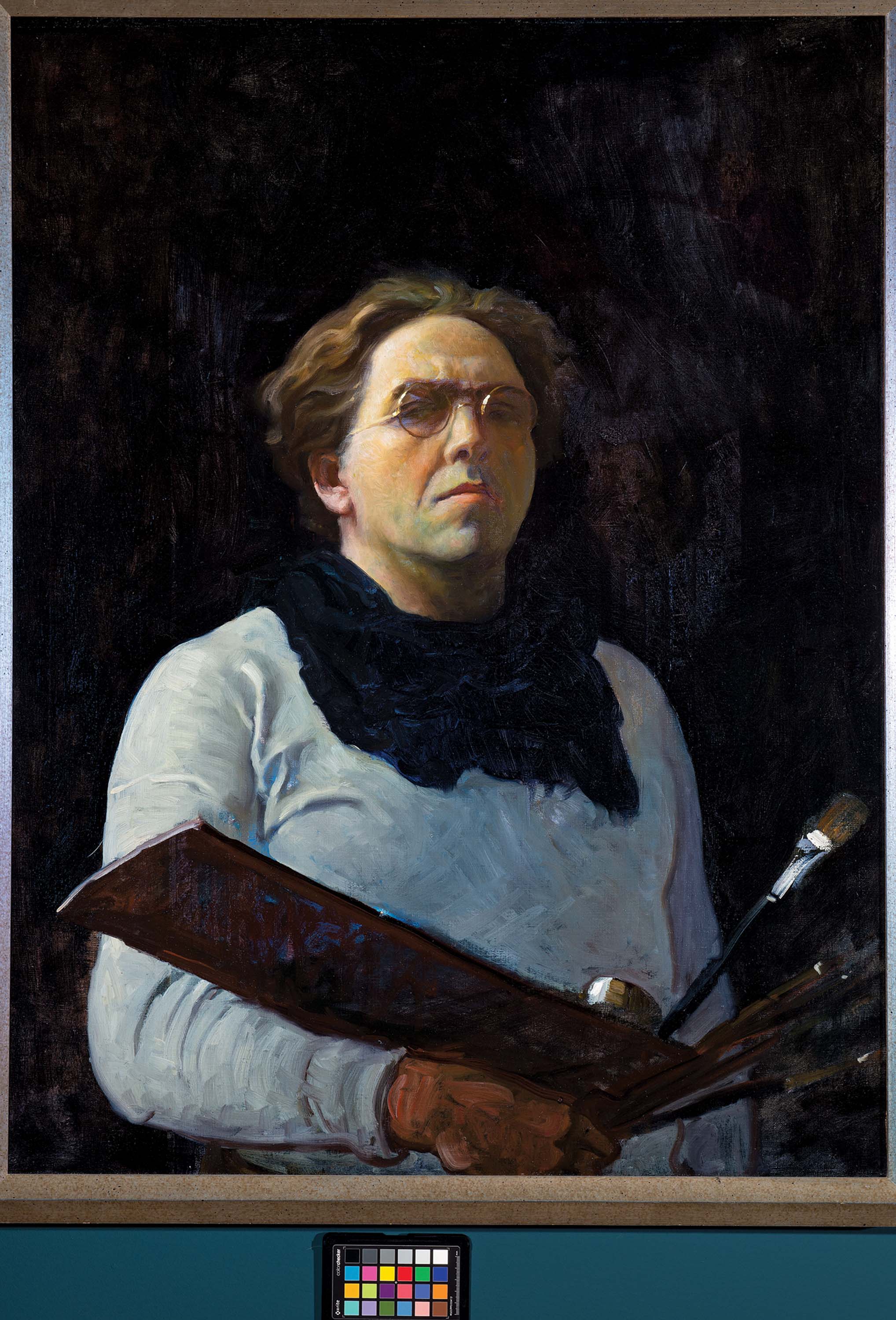

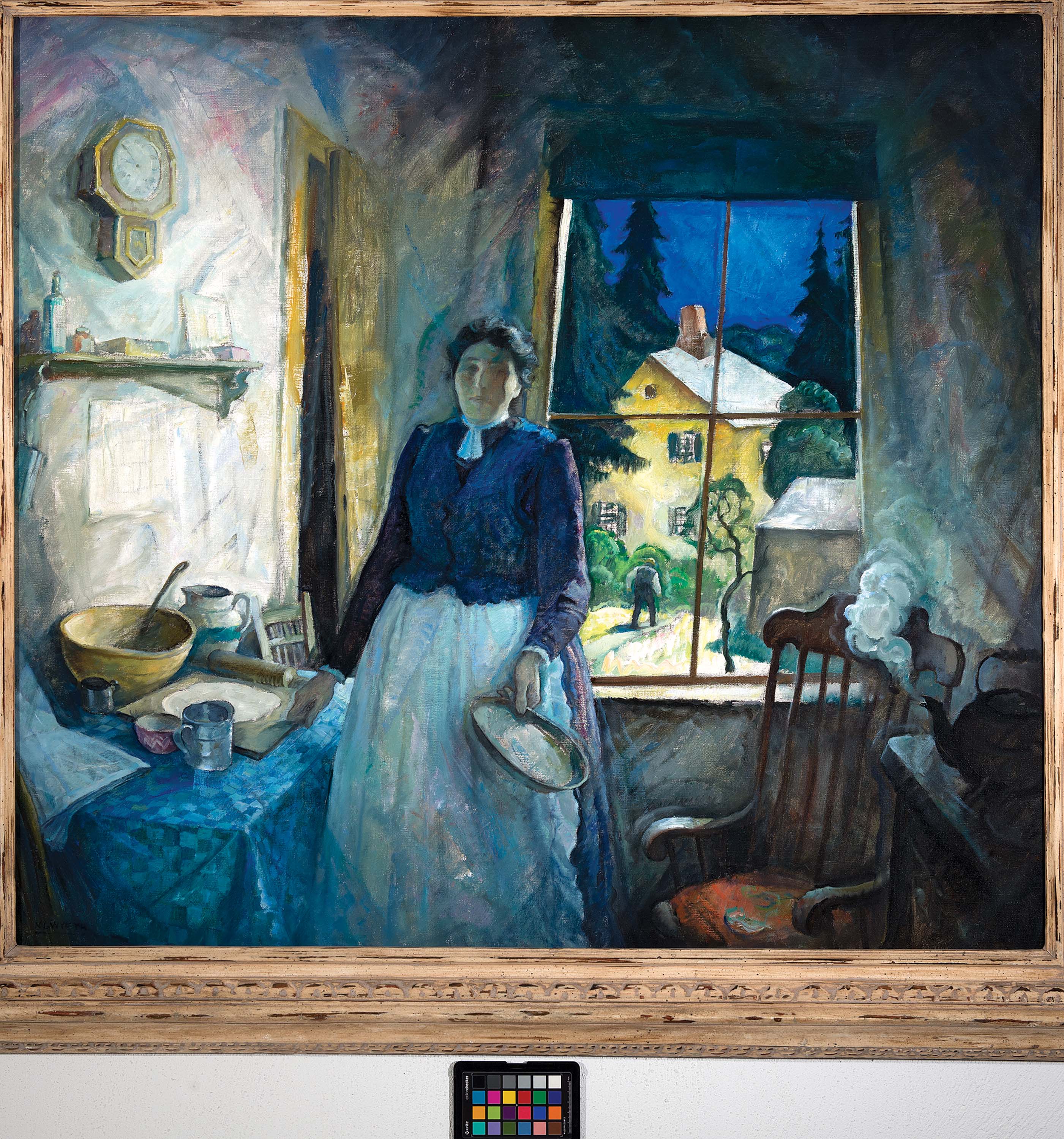
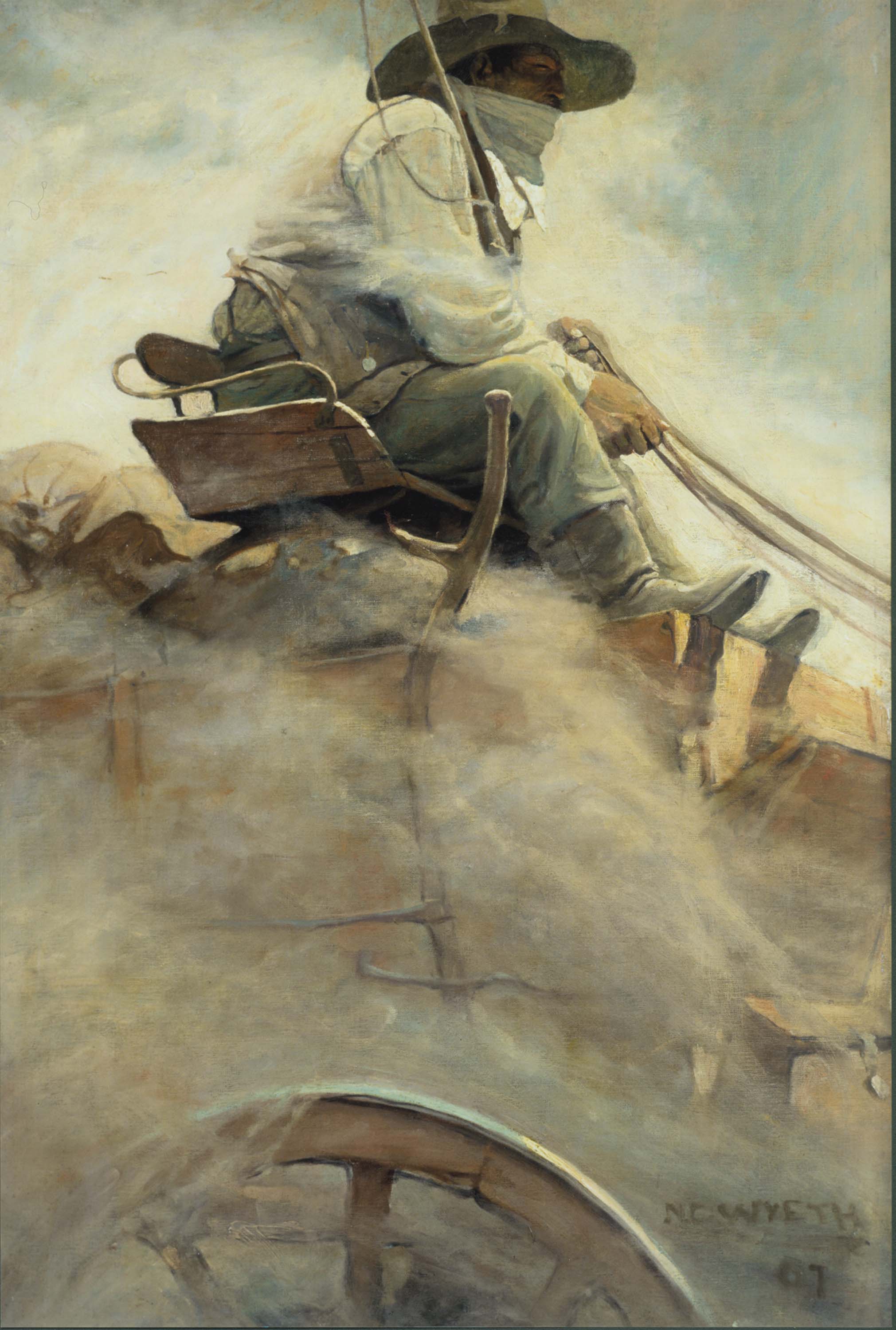
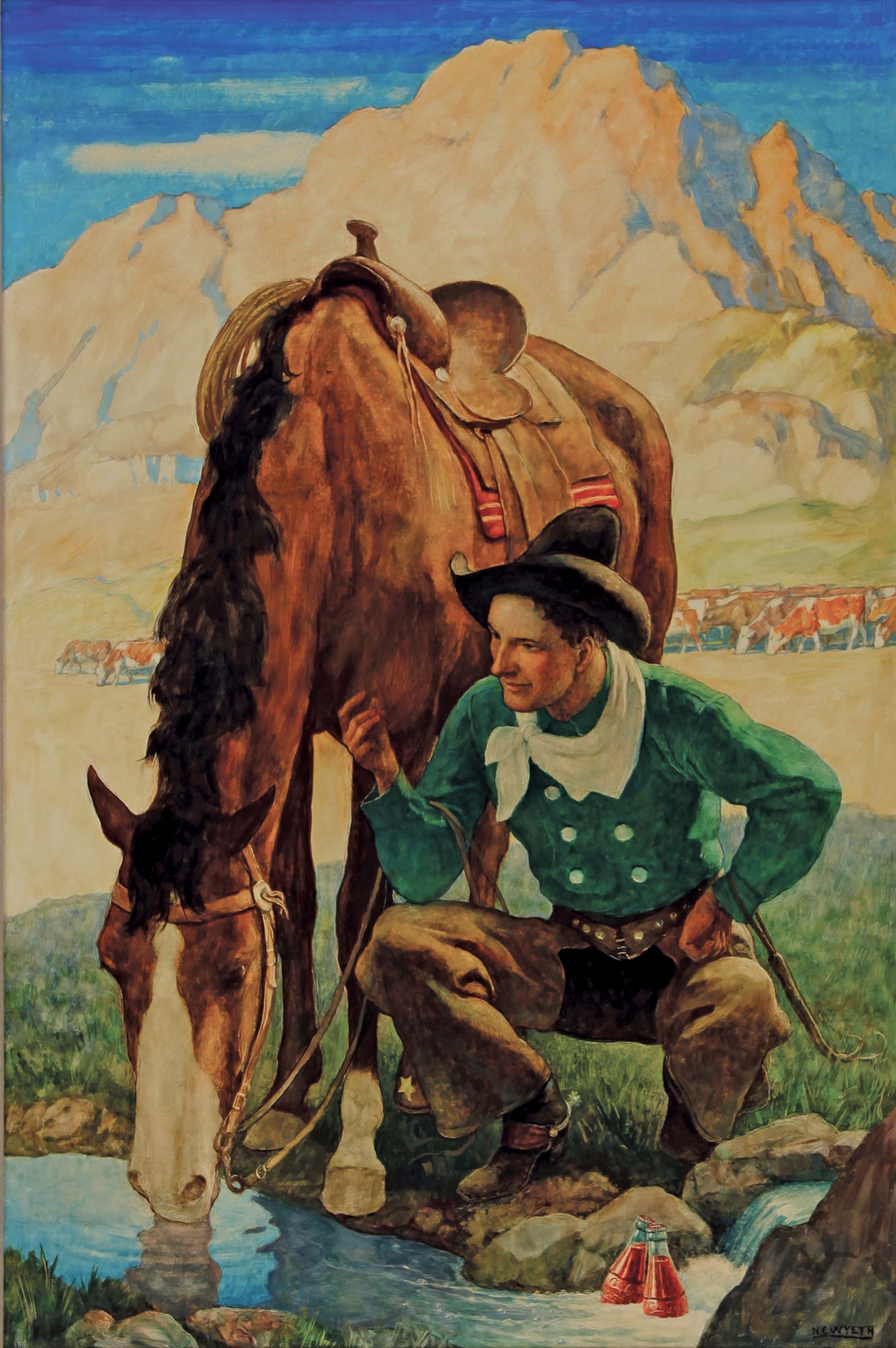
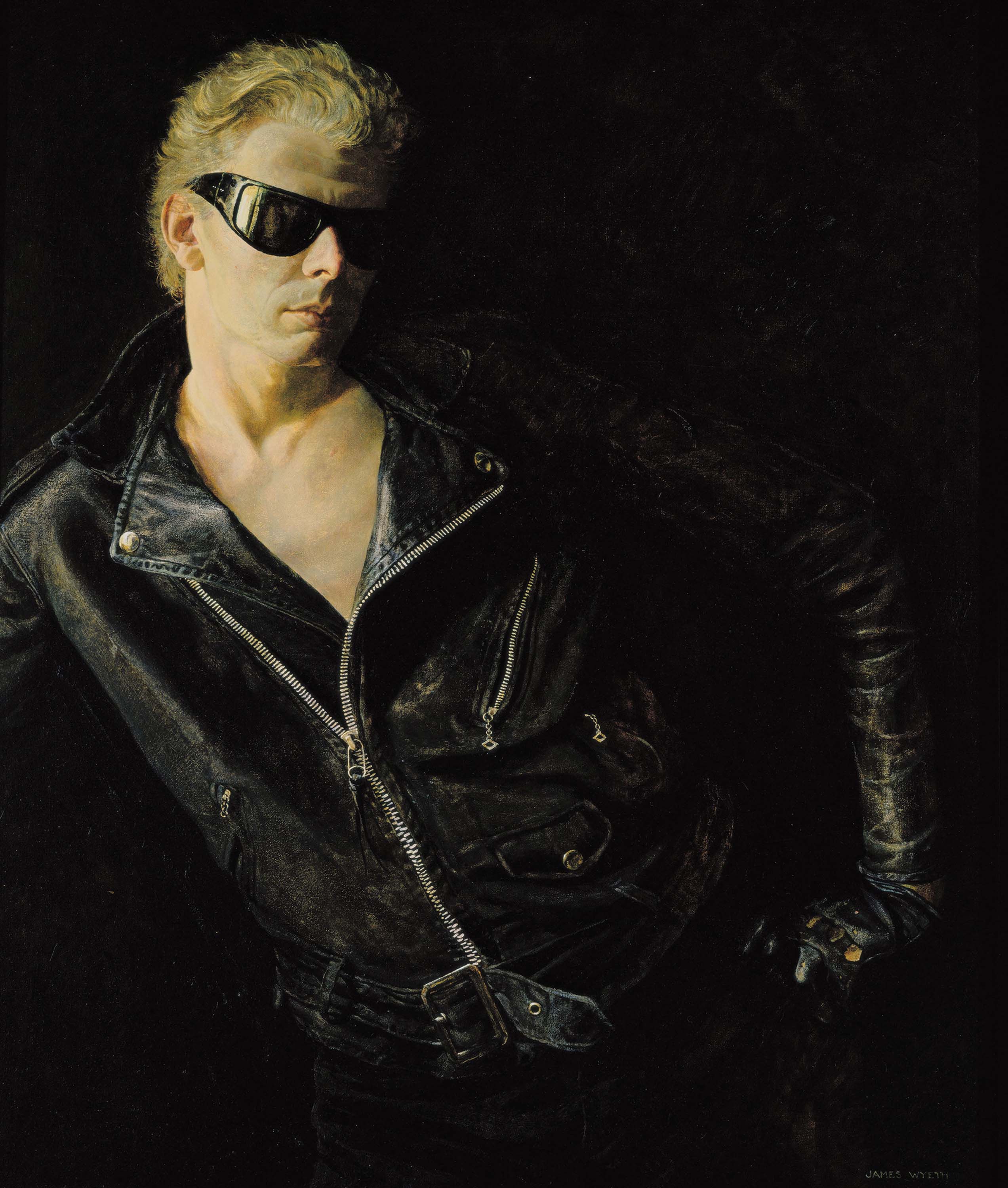
No Comments